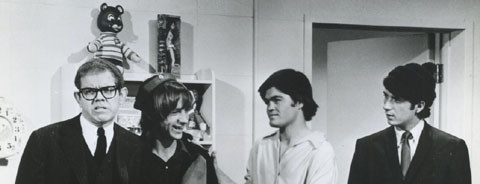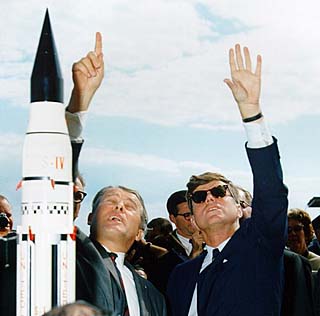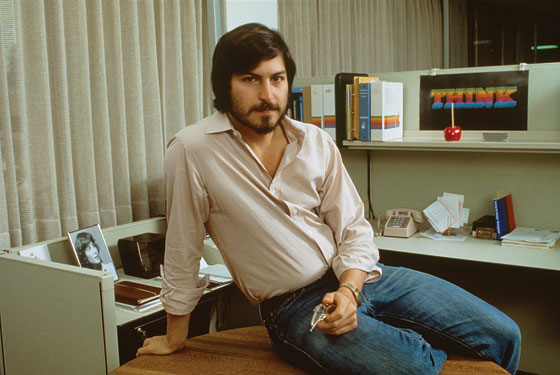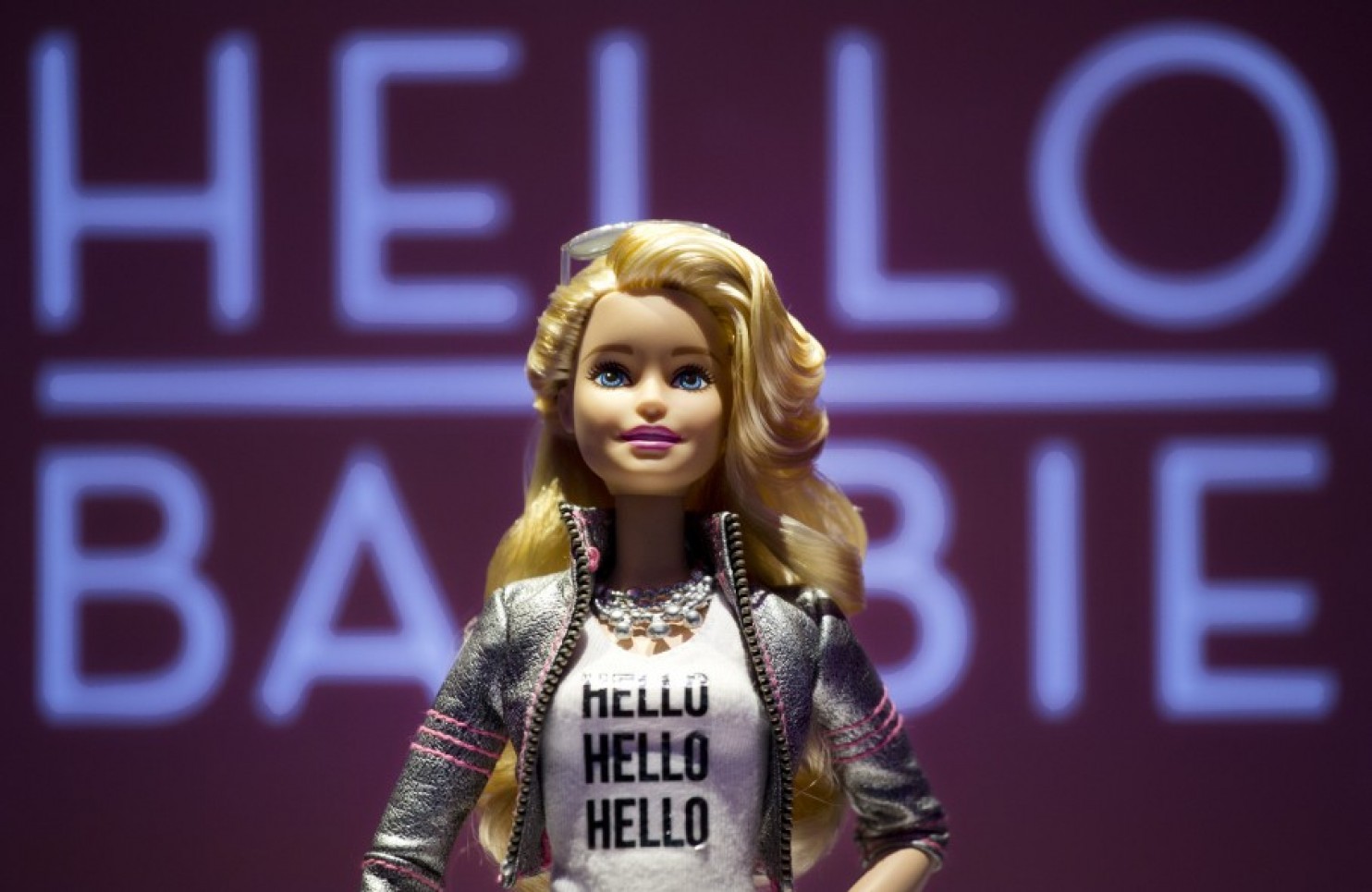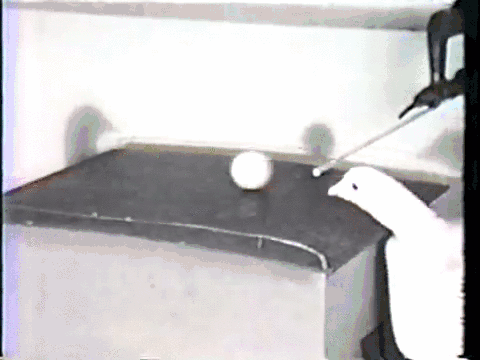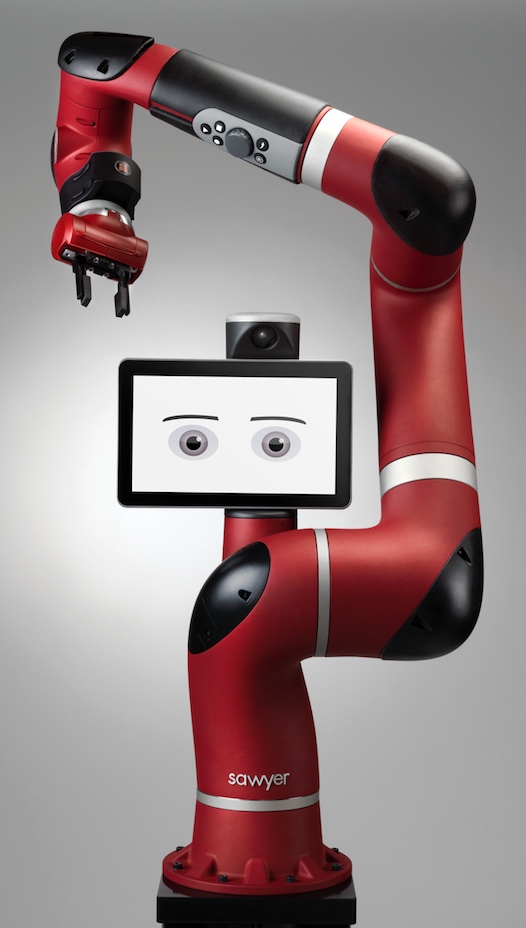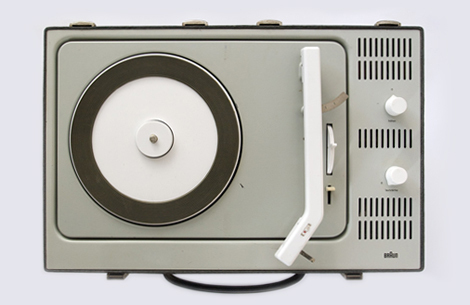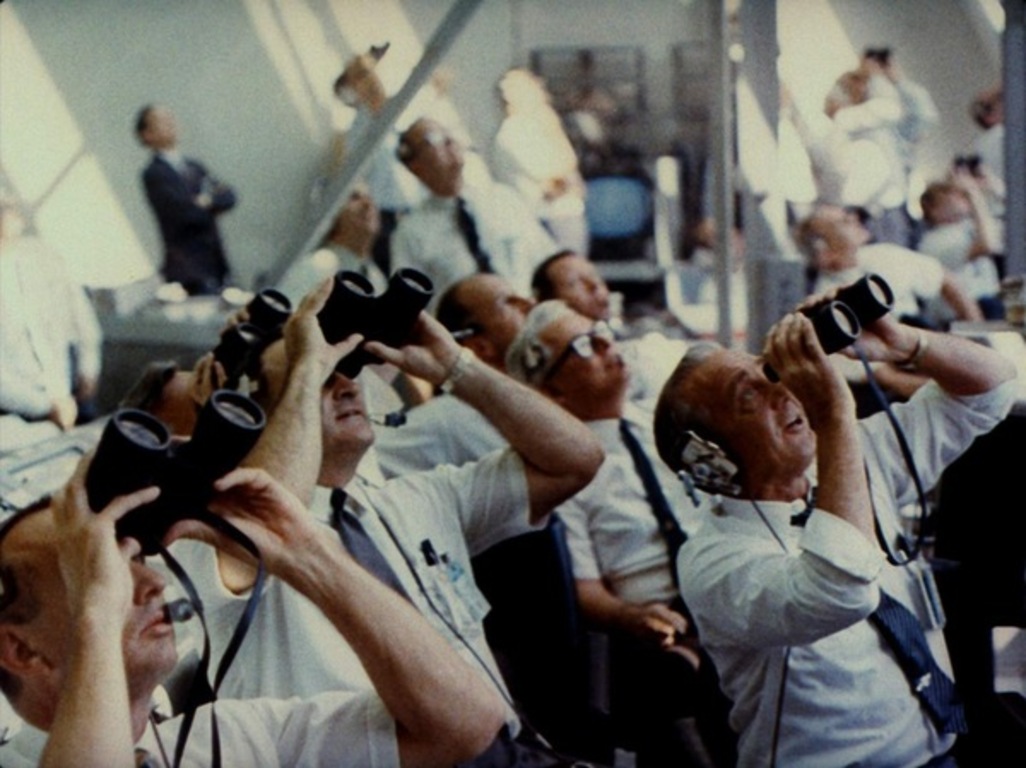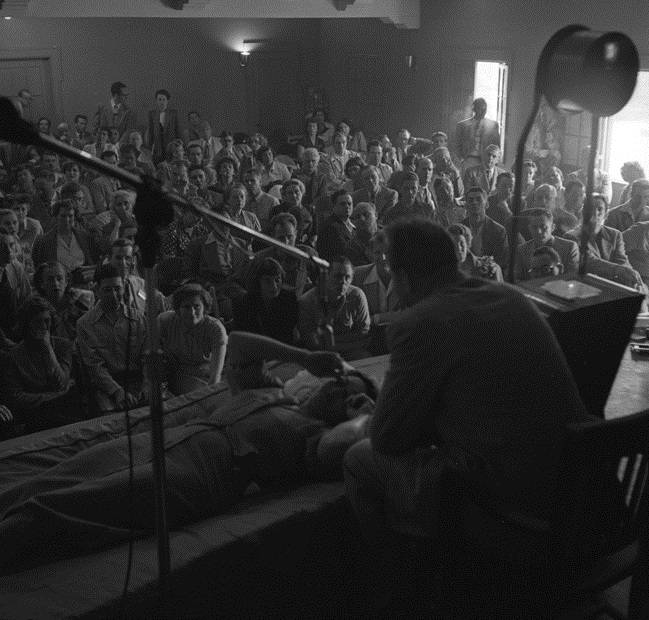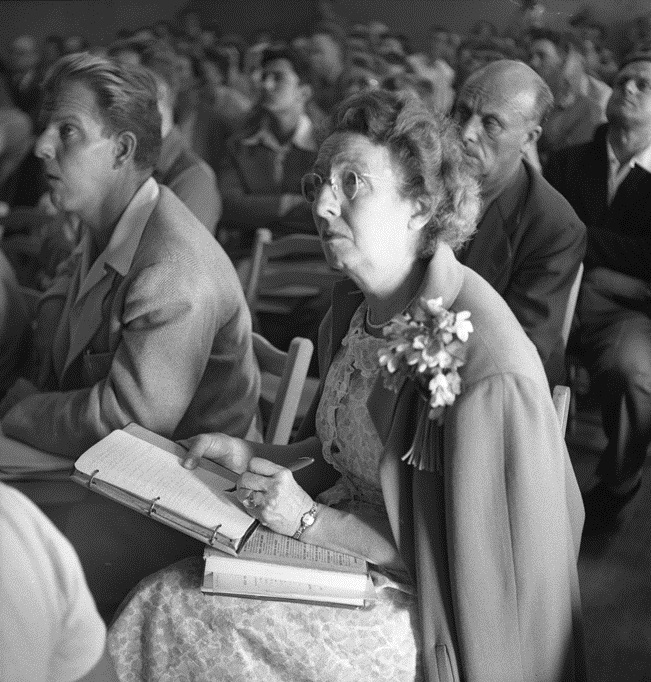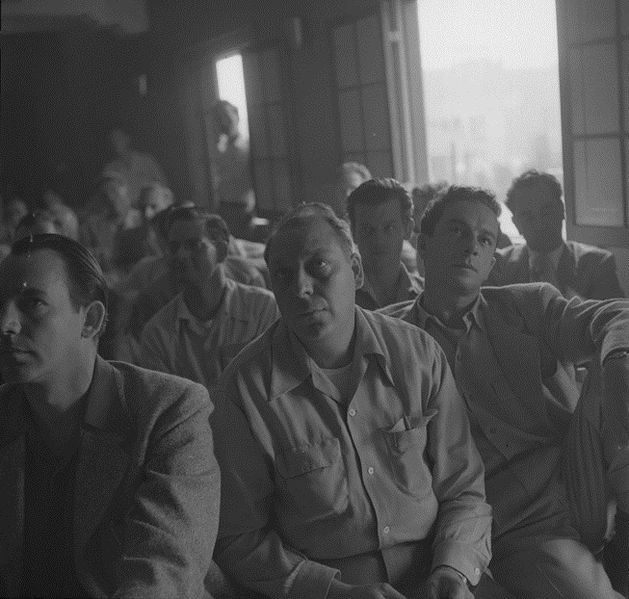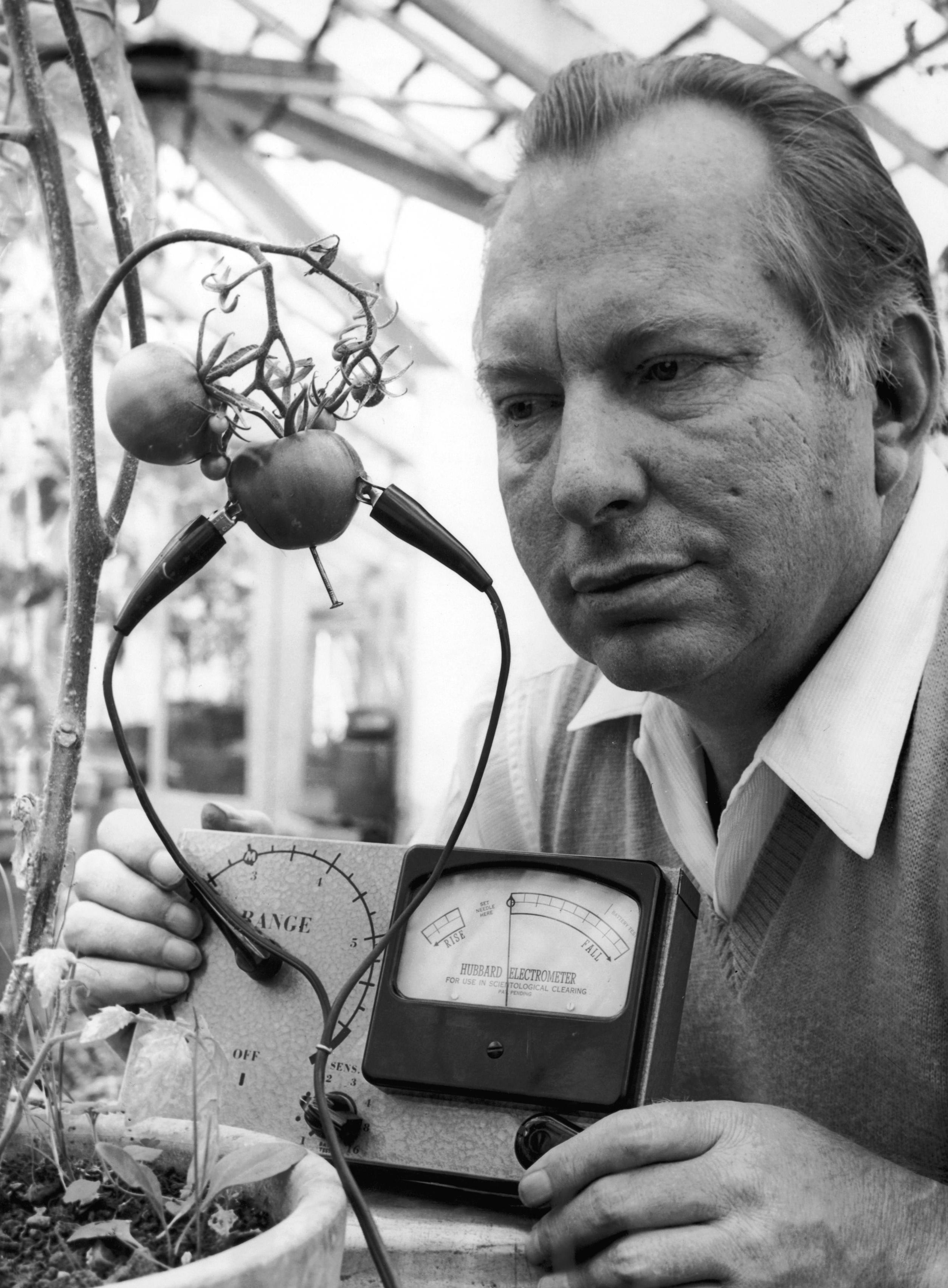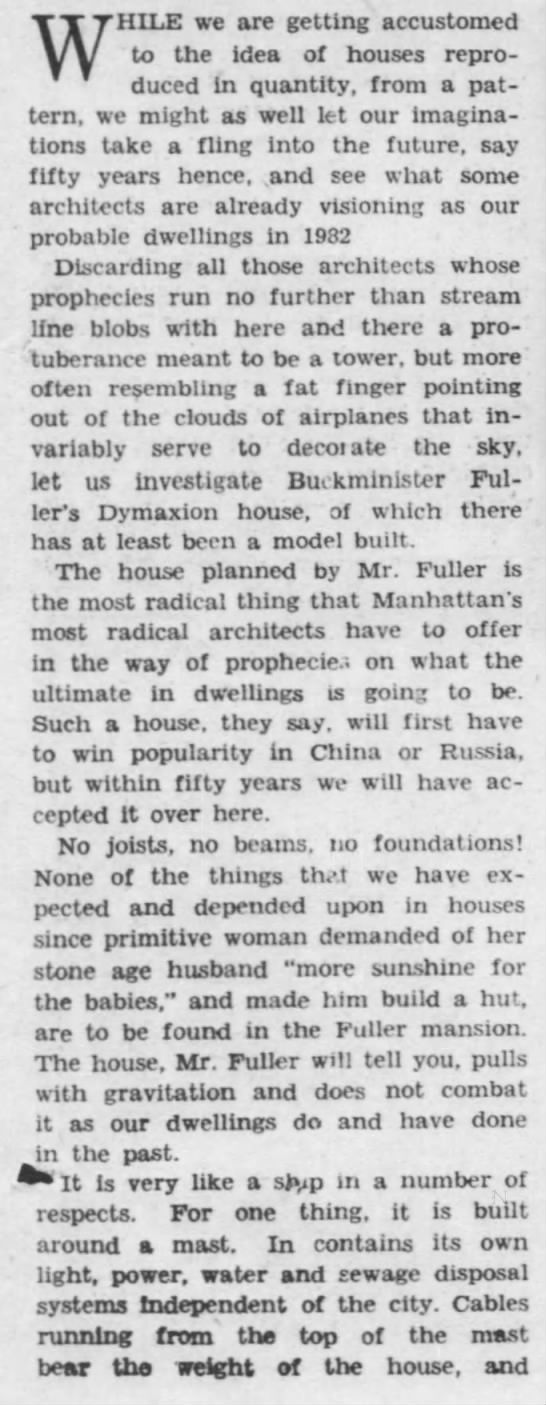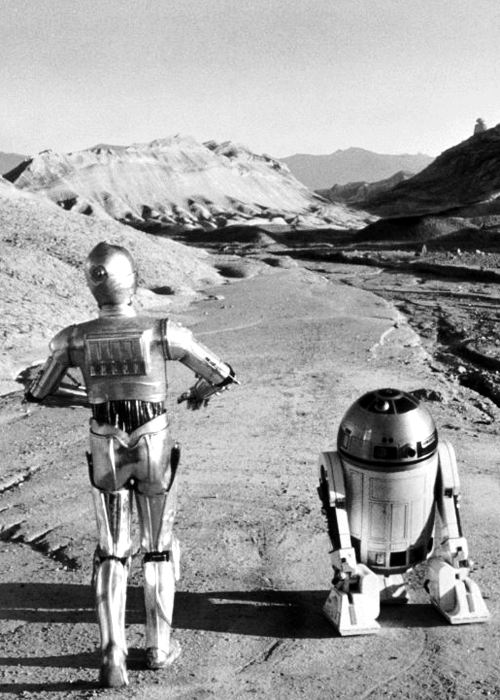A 1975 NASA video touting the design for the Stanford torus, the university’s proposal for a ring-shaped space colony. The agricultural model that was to provide sustenance was particularly interesting.
You are currently browsing the archive for the Videos category.
Festo’s eMotionButterflies, bionic and autonomous, participate in collective behavior and can likely be used for, among other things, the prettiest surveillance ever. From the company website:
Ten cameras installed in the room record the butterflies using their infrared markers. The cameras transmit the position data to a central master computer, which coordinates the butterflies from outside. The intelligent networking system creates a guidance and monitoring system, which could be used in the networked factory of the future.•
Stan Freberg, a household name for several decades in America, just passed away. He defied easy categorization, doing many things–satire, records, voice acting, radio, etc.–but was probably best at being an adman, lending the form a wryness and angst it hadn’t previously enjoyed. He was sort of the Philip Roth of the 30-second spot. Or maybe Joseph Heller? From his NYT obituary by Douglas Martin:
Mr. Freberg was a hard man to pin down. He made hit comedy records, voiced hundreds of cartoon characters and succeeded Jack Benny in one of radio’s most prestigious time slots. He called himself a “guerrilla satirist,” using humor as a barbed weapon to take on issues ranging from the commercialization of Christmas to the hypocrisy of liberals.
“Let’s give in and do the brotherhood bit,/Just make sure we don’t make a habit of it,” he sang in “Take an Indian to Lunch,” a song on the 1961 album “Stan Freberg Presents the United States of America,” a history lesson in songs and sketches. Time magazine said it may have been the “finest comedy album ever recorded.”
His radio sketches for CBS in 1957 included some of the earliest put-downs of political correctness (before that idea had a name). One sketch entailed a confrontation with a fictional network censor, Mr. Tweedlie, who insisted that Mr. Freberg change the lyrics of “Ol’ Man River,” starting with the title. He wanted it renamed “Elderly Man River.”
Mr. Freberg made his most lasting impact in advertising, a field he entered because he considered most commercials moronic. Usually working as a creative consultant to large agencies, he shattered Madison Avenue conventions. He once produced a musical commercial nearly six minutes long to explain why his client, Butternut Coffee, lagged behind its competitors by five years in developing instant brew.
His subversive but oddly effective approach caused Advertising Age to call him the father of the funny commercial and one of the 20th century’s most influential admen.•
_____________________________
With Dick Cavett, giving the Maharishi Mahesh Yogi a deserved roasting.
A vintage Freberg Cheerios commercial, which was very offbeat for the time.
Tags: Douglas Martin, Stan Freberg
I feel like I’ve been living inside the second album from Public Service Broadcasting, The Race for Space, for years, so I’m glad the band finally recorded it.
Instrumental music applied to archival radio news reports from the era make for something glorious and epic (despite a relatively brief 48-minute running time). It’s the age of Sputnik and Apollo convincingly and beautifully re-awakened by two musicians who weren’t even alive at the time of the moon landing. An oddity, perhaps, but one with a wide embrace. From Richard Hollingham at the BBC:
We are all familiar with the visual icons of the space race – such as Gagarin being lauded in Red Square the Earthrise picture from Apollo 8 or the American flag on the lunar surface – but, for Willgoose, audio has proved just as emotive.
“Radio has the best pictures, there’s a certain amount of imagination that this music calls upon,” he says. “Our live shows are so video-heavy and we get a lot of presumptions that the music is totally reliant on the images but I think it’s the other way round.”•
Tags: Public Service Broadcasting, Richard Hollingham, Yuri Gagarin
There’s another passage from Andrew O’Hehir’s recent Salon interview with Alex Gibney I wanted to put up when I published the Going Clear one, a section about his forthcoming Steve Jobs documentary, but it seemed odd to combine them. Although, you know, cults!
An excerpt in which the director tries to explain why he believes there was a deluge of grief over the passing of Jobs, a businessman:
Question:
How does your approach to Jobs differ from the conventional wisdom?
Alex Gibney:
It’s an impressionistic rumination on his life and what it means to us. I didn’t want to do a dutiful, stone-skipping, “Here are all the events in Steve Jobs’ life” movie. But I was interested in the idea that, when he died, people all over the world who didn’t know him from Adam were weeping. I mean, this guy was not like Martin Luther King Jr. or John Lennon. He was a businessman. But nobody is going to weep for Lloyd Blankfein when he goes. [Laughter.]
Question:
No. Or Bill Gates either, I think.
Alex Gibney:
Or Bill Gates, despite the fact that Bill Gates has contributed more to make the world a better place than Steve Jobs ever did. That’s one of the things we get at, because what I got interested in was values. Not just the story of technology, but the story of values. Why do we care so much about him? And I think the answer — I hate to say “the answer,” because then why bother making the movie — but one of the answers is that he was our guide through this world of the computer. He introduced us to it. He made the computer warm and fuzzy. He made us feel like we were one with the computer. He came very much out of counterculture. He took acid, he went to Reed College and dropped out, he traveled around the world. It was all about “Think Different,” and putting up billboards with Martin Luther King Jr. and Cesar Chavez and Rosa Parks.
Where did those values take us? By the end, they didn’t take us to such a nice place, although there are aspects of his life that I find very important and moving. For those who see the film as a slam, they’re looking at the wrong end of the telescope. Because a lot of the film is about us, it’s about how we deal with our machines. There’s a small group of people in the film, and they’re not always the ones you would think of. So I hope it ends up being an interesting and in some ways unexpected portrait. We spent a lot of time on his affection for Zen, for instance. We found some great footage of his spiritual adviser, Kobun Chino, talking about his first exchanges with Jobs. So it’s a meditation on many aspects of this person’s life.
Question:
Well, there’s such a contrast with Jobs. We have this person who was really a revolutionary and a visionary when it came to understanding the way people use technology, and then we have the effect he had on the culture of the American workplace.
Alex Gibney:
We definitely talk about that. And as I say, there’s the question of values, expressed in terms of how Apple used and uses its corporate power. It’s one thing for Jobs to give the finger to IBM as a young man. But when you’re atop the most valuable corporation in history and you’re still giving the finger, to whom are you giving the finger?
Question:
Yet Apple still somehow has this cultural cachet of being an underdog company who we’re all supposed to root for.
Alex Gibney:
Yes! And how that happens, I just don’t get. Last year I did a film about James Brown, and there’s a lot that’s similar about James Brown and Steve Jobs. He’s an awesome performer, on stage at those Apple events and presentations. Most people think of him as Edison. Steve Jobs was not Edison — he was a lot closer to P.T. Barnum.•
________________________________
Tags: Alex Gibney, Steve Jobs
In a few months, Mattel is releasing an interactive, Wi-Fi-enabled version of its most iconic doll, and it’s only surprising that Siri and Barbie haven’t met sooner. It could be a great moment for teaching–or marketing and surveillance. From Natasha Singer at the New York Times:
This fall, Mattel plans to introduce Hello Barbie, a Wi-Fi enabled version of the iconic doll, which uses ToyTalk’s system to analyze a child’s speech and produce relevant responses.
“She’s a huge character with an enormous back story,” Mr. Jacob says of Barbie. “We hope that when she’s ready, she will have thousands and thousands of things to say and you can speak to her for hours and hours.”
It was probably inevitable that the so-called Internet of Things — those Web-connected thermostats and bathroom scales and coffee makers and whatnot — would beget the Internet of Toys. And just like Web-connected consumer gizmos that can amass details about their owners and transmit that data for remote analysis, Internet-connected toys hold out the tantalizing promise of personalized services and the risk of privacy perils.
“Is this going to be some creepy doll that records what is going on in your home without you knowing it?” asks Nicole A. Ozer, the director of technology and civil liberties at the American Civil Liberties Union of Northern California. “What is being recorded? How long is it being stored? Who is it being shared with?”
The advent of connected toys that can record and talk back to children is likely to deepen this debate over the Internet of Things because of the potential for these intelligent toys to powerfully affect children’s imagination, learning and social development.•
________________________________
Sally Ride became the first American female to travel into space in 1983, and those enlightened designers at Mattel’s Barbie division were ready to pay tribute to the progress of women–well, to a point. Astronaut Barbie was a trailblazer in outer space, but she also enjoyed dancing in high heels under a disco ball. Seemingly intended for young girls with serious cocaine problems.
Tags: Natasha Singer, Nicole A. Ozer
Lawrence Wright, Going Clear writer, holds out hope that Scientology can reform itself, normalize, transition from cult to religion, but filmmaker Alex Gibney, who adapted the book into an HBO sensation, harbors no such faith. An exchange from one of Andrew O’Hehir’s customarily smart Salon interviews:
Question:
Larry speculates that it might be possible for the church to reform itself by doing what they did before on the issue of homophobia, and pretending that Hubbard’s bigoted and hateful remarks basically never existed. I think he’s being overly generous. I can’t imagine an organization that is this paranoid and this hateful finding a way to reinvent itself. Can you?
Alex Gibney:
No. Look at what’s happening now with Pope Francis and the Catholic Church. The weight of history is so strong, much stronger for the Catholic Church of course. But in the case of the Church of Scientology they would have to fundamentally uproot their belief system. Whether he was a bigot or just a creature of his age, Hubbard was virulently anti-gay and thought it was a disease that could be cured. How do you fix that unless you come out and say, “You know what? Hubbard was wrong about a lot of things.” And that’s hard to do. That’s what was so interesting about these individuals in our film: It was hard for them to wake up one day and say they had been wrong for 30 years.
I don’t know if you read this piece in the New Yorker recently, about the Jean McConville murder in Northern Ireland? It was a fascinating piece and one of the aspects that caught my eye was this one woman [Dolours Price] who was basically a hit woman for the IRA. She was very attractive, ended up marrying Stephen Rea. But when the Good Friday Accords happened, suddenly all the certainty she’d had that allowed her to believe that the end justified the means had been removed. And it sent her into a tailspin. Once that certainty is gone – I mean, it’s a wonderful kind of narcotic. I think that for Danny Masterson and Bodhi Elfman, it probably feels good to say, “Those are hateful bastards saying this stuff.” Because it’s pure; it may be hate but it’s pure hate, and it feels good because you’re certain. But when your certainty is removed, what’s left?•
_____________________________
“Yes, and Jane came by with a lock of your hair
She said that you gave it to her
That night that you planned to go clear
Did you ever go clear?”
Tags: Alex Gibney, Andrew O'Hehir
B.F. Skinner, who felt we could use some training, created a Teaching Machine in the 1950s to help improve our behavior. Thanks to the wonderful 3 Quarks Daily, I read Sophia Nguyen’s Harvard Magazine article about the reconsideration of Skinner’s contraption in the computer age, as classrooms become increasingly plugged in. The goal for such machines should, of course, be something other than teaching us chickens how to play tic-tac-toe. In investigating gaming as learning, Nguyen writes of the vision of designer Eric Zimmerman:
Future generations will understand their world in terms of games and systems, and will respond to it as players and designers—navigating, manipulating, and improving upon them.
The opening:
ON NOVEMBER 11, 1953, psychology professor B.F. Skinner sat in a fourth-grade math class, perturbed. It was Parents Day at his daughter Deborah’s school. The lesson seemed grossly inefficient: students proceeded through the material in lock-step, at the same pace; their graded assignments were returned to them sluggishly.
A leading proponent of what he called “radical behaviorism,” Skinner had devoted his career to studying feedback. He denied the existence of free will and dismissed inner mental states as explanations for outward action. Instead, he focused on the environment and the organism’s response. He had trained rats to push levers and pigeons to play Ping-Pong. A signed photo of Ivan Pavlov presided over his study in Cambridge. Turning his attention to a particular subset of the human animal—the schoolchild—Skinner invented his Teaching Machine.
Roughly the size and shape of a typewriter, the machine allowed a student to progress independently through a curriculum, answering test items and getting instant feedback with a few pulls of a lever. “The student quickly learns to be right. His work is pleasurable. He does not have to force himself to study,” Skinner claimed. “A classroom in which machines are being used is usually the scene of intense concentration.” With hardly any hindrance from peers or teachers, thousands of students could receive knowledge directly from a single textbook writer. He told The Harvard Crimson, “There is no reason why the school room should be any less mechanized than the kitchen.”
Sixty years later, Skinner’s reductionist ideas about teaching and learning continue to haunt public education—especially as it’s once again being called upon to embrace technology.•
_______________________________
Teaching machine and programmed learning, from 1954:
Tags: B.F. Skinner, Eric Zimmerman, Sophia Nguyen
Robots that deliver coffee to your suite of rooms are swell, but robotics enters another phase when machines can use Deep Learning to grow and adapt. Of course, we might not always like what they do with their newfound knowledge. From Technology.org:
In the near future we may have household robots to handle cooking, cleaning and other menial tasks. They will be teachable: Show the robot how to operate your coffee machine, and it will take over from there.
But suppose you buy a new, different coffee maker. Will you have to start over?
“The robot already has seen two or three coffee machines; it should be able to figure out how to use this one,” said Ashutosh Saxena, assistant professor of computer science. In robotics work up to now, he noted, a robot must be trained for each task and always positioned in the same relationship to the machine and its controls.
In his Robot Learning Lab, Saxena is making robots more adaptable. A new deep-learning algorithm developed by Saxena and graduate student Jaeyong Sung enables a robot to operate a machine it has never seen before, by consulting the instruction manual – probably available online – and drawing on its experience with other machines that have similar controls.
One thing that makes this hard is the “noise” in natural language instructions. Do you turn on the machine with a “knob” or a “switch?” Do you dispense coffee by pulling a “handle” or a “lever?” And then, where is that control on the machine, and what’s the proper way to manipulate it? For this, the robot draws on a database of recorded actions.
“We use a deep learning neural network that can tell the robot which action in a database is the closest to the one it has to perform,” Sung explained.•
______________________________
“Press the button to start grinding”:
Tags: Ashutosh Saxena, Jaeyong Sung
The graphic designer Massimo Vignelli, who passed away nearly a year ago, left a mark on New York City that’s dwarfed only by those on the level of Robert Moses and Frederick Law Olmsted. Here’s an excerpt from a 2006 Gary Hustwit interview with Vignelli (republished by Fast Company) in which the man who somehow made sense of our serpentine subway comments on the impact of modern machines on signage:
Question:
What’s your opinion of the impact of the computer on typography?
Massimo Vignelli:
In the ’60s, we were taking Standard and cutting the sides of the letters in order to get the type tighter. A good typographer always has sensitivity about the distance between letters. It makes a tremendous amount of difference. We think typography is black and white. Typography is really white, you know. It’s not even black, in a sense. It is the space between the blacks that really makes it. In a sense, it’s like music—it’s not the notes; it’s the space you put between the notes that makes the music. It’s very much the same situation.
The spacing between letters is important, and the spacing between the lines is important, too. And what typographers do, what we do all the time, is continuously work with those two elements, kerning and leading. Now, in the old times we were all doing this with a blade and cutting type and cutting our fingers all the time. But eventually, thank God, the Apple computer came about. Apple made the right kind of computer for the communication field. IBM made the PC, and the PC was no good for communication. The PC was great for numbers, and they probably made studies that there were more people involved with numbers—banks, insurance companies, businesses of all kinds. But they made a tremendous mistake at the same time by not considering the size of the communications world. That community is enormous, you know—newspapers, television, anything that is printed. It’s enormous. Advertising, design, you name it.
Anyhow, Apple, thank God, got the intuition of going after that market, and so in 1990 they came out with a computer that we designers could use. Now, let’s face it: the computer is a great thing, but it’s just a tool, just like a pencil is a tool. The computer has much more memory, the pencil has no memory whatsoever, and I have even less. But it is a fantastic tool which allowed the best typography ever done in the history of typography, because you can do the kerning perfectly for the situation. You can do the leading perfectly for whatever you’re encountering. Not only that, but you see it right away; you can print it right away. It brings immediacy to your thoughts, and that is something that never happened before in the history of mankind.
It allows you to do the best typography ever, but it also allows you to do the worst ever.•
___________________________
“It’s the space between the notes”:
Tags: Gary Hustwit, Massimo Vignelli
Speaking of Norman Mailer, here’s a clip from a 1979 Firing Line in which William F. Buckley sits down with the pugilistic prose writer at the time of The Executioner’s Song. Twenty-five years after using his “nonfiction novel” to profile the life and firing-squad death of murderer Gary Gilmore, Mailer guested on the Gilmore Girls. Strange life.
My blood boils at even the thought of Grey Gardens, that exercise in gawking and cruelty, but in the wider picture, Albert and David Maysles did amazing work. Gimme Shelter is one of the most perfect films I’ve ever watched, from its structure to its content, and Salesman, which just floors me, has never been timelier, with its depiction of the pawns left in the wake of the Disruption Machine. Albert, the remaining brother, passed away a couple weeks ago. Here’s a clip from the brothers’ 1963 film Orson Welles in Spain, in which the great and star-crossed director presages the fraying of the traditional studio picture, with its formality. The work he’s discussing turned out to be his uncompleted 1970s movie The Other Side of the Wind.
Tags: Albert Maysles, David Maysles, Orson Welles
Robots needn’t be conscious to help or hurt us, to serve or displace us. One possible remedy to the fears about an automation proliferation is human-machine collaboration. For example: In freestyle chess, teams comprised of one human and one computer regularly obliterate a lone person or computer. Will human employees be paired with robots in the same way?
Two things: 1) Such tandems will still checkmate a lot of workers, and 2) It may be the “detente” is only temporary, the human half of the equation gradually phased out. From a report about you newest coworker–a cobot–from Tanya Powley at the Financial Times:
Meet Sawyer. It is the newest robot on the block designed to speed up automation in factories by taking on tasks that once relied on humans’ manual dexterity and good eyesight.
The machine is one of two new “collaborative” robots, or co-bots, launched this week that are part of a new generation of affordable lightweight robots that are unlocking new markets and applications beyond automotive and semiconductor manufacturing, where robots have been a mainstay for decades.
Robot companies have been rushing to develop co-bots, which can work side-by-side with employees rather than behind a safety cage, as they look to capitalise on a growing trend by manufacturers to turn to technology to compete amid rising wage costs and labour shortages.
Unveiled on Thursday, Sawyer is made by US-based Rethink Robotics, which already builds a dual-arm humanoid robot known as Baxter. The single-armed Sawyer is more accurate, faster and smaller than Baxter, enabling it to automate a wider range of tasks such as machine tending and circuit board testing in the electronics industry. It can also carry a larger weight. Baxter has largely been used for packing purposes in factories and for academic research. …
Lightweight collaborative robots are cheaper, more dexterous, easier to move between tasks and do not require specialist programming skills. Many of them can be taught new moves by simply taking the robot arm and moving it to show it what to do. …
Sawyer will be marketed for $29,000, compared with a six figure sum for an industrial robot. Universal Robots sells its flexible, lightweight robot arms for between €20,000 to €30,000.
This has helped make automation more accessible for small and medium-sized businesses that previously could not afford the expensive heavyweight traditional industrial robots or did not consider them economical for smaller production volumes or contract manufacturing.•
Tags: Tanya Powley
You don’t have to read too much between the lines to understand that Braun design legend Dieter Rams, in his dotage, maybe regrets devoting his life to the field despite being so brilliant at it. I don’t think that’s such an unusual reaction to being on the wrong side of aging, no matter the accomplishments. Three excerpts follow from Gary Hustwit’s Fast Company Q&A with Rams.
__________________________
Question:
How has design changed in the last 50 years?
Dieter Rams:
What I am especially bothered by today is that, particularly in the media, design is being used as a ‘lifestyle asset.’ I’m bothered by the arbitrariness and the thoughtlessness with which many things are produced and brought to the market. There are so many unnecessary things we produce, not only in the sector of consumer goods, but also in architecture, in advertising. We have too many unnecessary things everywhere. And I would even go as far as to describe this as inhumane. That is the situation today. But actually, it has always been a problem.
We need to deal with our resources differently, in terms of how we waste things. We have to move away from the throwaway habit. Things can, and must, last longer. They must be designed so that they can be reused. We need to take more care of our environment. That means not only our personal environment but also our cities and our resources. That is the future of design, to take more care of these basic elements. Otherwise I’m not sure what the future of our planet will be. So designers have to take on that responsibility, and to do so we need more support from government. We need political support to solve the problems with our environment and how we should shape our cities. As designers, we shouldn’t be doing this for ourselves, but for our community. And the community needs support, not only to interact with each other democratically, but it also needs support to live democratically.
__________________________
Question:
If you were to design a computer now, what would it look like?
Dieter Rams:
It would look like one of Apple’s products. In many magazines, or on the Internet, people compare Apple products to things which I designed, with this or that transistor radio from 1965 or 1955. In terms of aesthetics, I think their designs are brilliant. I don’t consider it an imitation. I take it as a compliment.
__________________________
Question:
Is there anything else you’d like to talk about that we haven’t covered so far?
Dieter Rams:
Well, I’m not very active in the design field anymore. I have only a few things to do, mainly in the furniture sector, because I have certain commitments. But I am still very interested in what’s happening, and it is my wish that we really do deal with our surroundings more consciously in the future. That is really my wish, because I believe it contributes to living with one another more peacefully. That’s why, if I had something to do in this world again, I would not want to be a designer. Because I believe, in the future, it will be less important to have many things and more important to exercise care about where and how we live.•
__________________________
A scene from Objectified, 2009.
Tags: Dieter Rams, Gary Hustwit
While his 1974 adaptation of Libertarian tract, The Incredible Bread Machine, drops my jaw with its intense anti-government paranoia, filmmaker and sculptor Theo Kamecke’s 1970 documentary, Moonwalk One, is a poetic, moody and beautiful work. Funny that it was lost for decades since it was built for the ages.
Tags: Theo Kamecke
Jacque Fresco, one of those fascinating people who walks through life building a world inside his head, hoping it eventually influences the wider one, turns 99 today. A futurist and designer who’s focused much of his work on sustainable living, technology and automation, Fresco is the brains behind the Venus Project, which encourages a post-money, resource-based economy. An excerpt from a 1985 Sun Sentinel profile by Scott Eyman followed by two videos, the first about Venus and the second a 1974 interview with Fresco conducted by a pre-suspenders Larry King.
__________________________
You can hear the glorious, smoothly humming hydraulic future in Jacque Fresco`s eager voice, see it in the eye in your mind. Cities and their inhabitants thrive under the sea. Houses are heated by pipes laid beneath highways that conduit the gathered asphalt heat into private residences. Grain is stored in the natural refrigerator of the polar regions.
Fossil fuels have been abandoned, as solar power runs everything from your air-conditioning — if you need it in houses that are properly built and insulated, which you probably won`t — to your backyard barbecue, where a mirror and two pyrex reflectors cook both sides of the meat at the same time. And when something goes wrong with your car, two handles are turned, the entire engine unit pulls out, a courtesy engine is plugged in and you`re back on the road while the garage works to find the problem.
Welcome to the future, or at least Jacque Fresco`s vision of it. It all seems eminently attainable . . . until you open your eyes and look around. What you see are 22 acres with four organically flowing domed structures — two of which are finished, one of which is furnished — a little lake with a baby alligator sunning himself by the water`s edge, and a landscaped path leading back among 400-year-old cypress trees. It is here, on this quiet patch of land in Venus, Fla., that Jacque Fresco and his companion, Roxanne Meadows, are constructing a prototype of the possible.
“I tried walking around with a briefcase, and selling myself,” says the peppery Fresco, a vigorous and muscular 69. “And I found that people think you`re an idiot if you don`t have anything to show them, if all you have are ideas and a vision. All right. I`ll show them something.”
Welcome to the world of Jacque Fresco, social conceptualist and inventor, one of those people who create something tangible where before there existed only that most intangible of intangibles: an idea.•
Tags: Jacque Fresco, Larry King, Scott Eyman
In 1954, a year after Edmund Hillary and Tenzing Norgay became the first to scale Mt. Everest, the former appeared on an episode of Omnibus, telling the story of the historic climb. The duo spent just 15 minutes at the peak, being low on oxygen supply.
Tags: Edmund Hillary, Tenzing Norgay
It’s pretty clear privacy is all but over, even inside the home. The Internet of Things will likely be the thing pretty soon, and once every last appliance is connected, the quantifying and monitoring will begin in earnest. Many positive advances will be made because of this new counting machine–yes, we will all count!–but the catch, of course, is that there’ll be no way to opt out, no choice. You too will be judged. From Sarah Butler at the Guardian:
“We are coming to the era of the connected customer, the latest in a series of shifts created by technology,” [Dixons Carphone CEO Seb James] told the Retail Week Live conference in London. “This shift is going to bump off as many retailers as the last. It will be a total asteroid strike at the heart of retail.”
The new technology, from health monitoring smartwatches to washing machines that can tell engineers when they need repairing – will mean retailers need to offer services to help consumers with the new products and keep them operating correctly. …
“Your connected home will know when you’re in, what mood you’re in, your temperature preferences and family members. They’ll know the state of health of your dog, how far you jogged this morning and what brand of toothpaste you like and how much you have left.
“It’s a little bit creepy but we’re all going to have to get used to it as information which used to be so hard to get is now going to be so easy to find new skills and tools [to deal with it].”•
______________________________
“What will it be like? How will we choose to live?”
Tags: Sarah Butler, Seb James
When Timex introduced cheap, seemingly unbreakable watches in the 1950s, the product was given short shrift by both media and jewelers, but they soon were category leaders. The Timex Data Link of the 1990s, however, made in conjunction with Microsoft, was probably lavished with too much praise. Before computers were tiny and powerful, the Data Link was the first watch that could receive downloaded information. It wasn’t good enough, but it was (sort of) the future. As Apple releases more information today about the iWatch that no one seems to be clamoring for, here’s an excerpt from a 1994 New York Times article about the Data Link followed by a commercial for it.
“Talk about information at your fingertips. The Timex Corporation and the Microsoft Corporation said today that they had teamed up to develop a wristwatch that can store information received directly from a personal computer screen.
The Timex Data Link watch, which will cost about $130 when it goes on sale in September, uses a wireless optical scanning system to receive data from Microsoft software.
The Data Link watch was demonstrated today at a presentation by Microsoft’s chairman, Bill Gates, who held it up to a computer as a series of bar-code lines flashed on the screen. After several seconds, Mr. Gates was able to scroll through personal information like appointment locations and telephone numbers at the touch of a button on the watch.
Fast Sales Predicted
C. Michael Jacobi, the president of Timex, predicted that the company would sell 200,000 of the watches in the final three months of this year, making it the fastest-selling watch ever in its price category.
The new watch looks like a regular round sports watch and includes such standard digital watch functions as a calendar, light, dual time-zone settings and alarms.
Using a microchip developed by Timex with Motorola Inc., the watch can store about 70 messages in its memory, downloading them in about 20 seconds, officials said.
Each watch will include software compatible with Microsoft Windows 3.1 and the company’s scheduling applications, such as Schedule Plus. The software also will be compatible with future versions of Windows, including a ‘Chicago’ upgrade expected out by the end of the year.
Users simply need to hold the watch about a foot away from their computer screens to download data, which can be done as often as needed.
Laptops Won’t Work
However, road warriors will be disappointed to learn that the watch will not work with laptop computers, which do not have a strong enough lighting source in their screens, Timex officials said.”•
Ross Andersen, Deputy Editor of Aeon, appearing on Tony Dokoupil’s MSNBC show, Greenhouse, to discuss existential risks to humanity and a potential colony being established on Mars by Elon Musk and SpaceX, a topic he covered at length in an excellent 2014 article.
Tags: Elon Musk, Ross Andersen, Tony Dokoupil
A house that’s impervious to storm and earthquake sounds pretty good right about now, and that was what Buckminster Fuller promised in 1929 when he introduced the Dymaxion House, an architectural dream never realized beyond a few prototypes. In a 1932 Brooklyn Daily Eagle article from a series on the future of the home, Fuller’s automated abode was given a public hearing. The opening of the piece below.
____________________________
“We are living in a spheroidal universe”:
Tags: Buckminster Fuller, Lou Wylie
Google has withdrawn one of its recently purchased companies from the upcoming DARPA Robotics Challenge in Pomona, but the competition will continue apace, albeit with some accelerated marching orders (i.e., the cables have been cut). From Erico Guizzo at IEEE Spectrum:
In a call with reporters this afternoon, Gill Pratt, program manager for the DRC, said the tasks for the final challenge will be similar to the ones we saw at the trials. But this time the tasks will be “put together in a single mission” that teams have one hour to complete.
The robots will start in a vehicle, drive to a simulated disaster building, and then they’ll have to open doors, walk on rubble, and use tools. Finally they’ll have to climb a flight of stairs. But one more thing, Pratt said: there will be a surprise task waiting for the robots at the end.
Just when we thought the DRC couldn’t get any cooler—it just did. Naturally, Pratt declined to elaborate on what this mystery task might entail.
He also emphasized that now the robots will operate completely untethered. There won’t be cables to provide power and data—and to keep them from falling down. “They’ll have to get up on their own,” he said. “That’s raising the bar on how good the robots have to be.”•
___________________________
“Basically we have to cut the cord”:
Tags: Erico Guizzo, Gill Pratt
I posted last fall about Aloft Hotels introducing robotic butlers, machines that will likely be roaming the halls of every hotel chain in the near future. Here’s video footage of one such “worker” providing room service.
Allen Ginsberg was a great poet and performer, if a dubious person in other ways. Here he is in 1965 giving one of his rapturous readings at the Royal Albert Hall.
Tags: Allen Ginsberg



